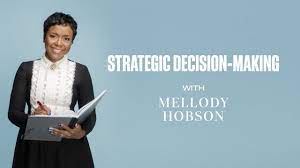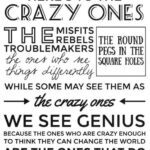In 1991, Mellody Hobson joined Ariel Investments—America’s first Black-owned mutual fund, the firm founded by John Rogers Jr. in 1983. She is presently Co-CEO, President and Chairman of the Board of Trustees of Ariel Investment Trust. In 2019, she became the first Black woman president
and co-CEO of an investment fund when she stepped into those roles at Ariel.
In Mellody Hobson’s masterclass, she delves into how to hone your own strategic decision-making skills and access two real-life case studies that exemplifies how she applied these tools in complex business situations.
- Mellody Hobson: President and co-CEO of Ariel Investments
- Location: Chicago, Illinois
- Education: Bachelor of Arts degree from the Woodrow Wilson School of International Relations and Public Policy at Princeton University (Princeton, New Jersey)
- Career Highlights: She serves on the advisory board of Starbucks and JPMorgan Chase & Co. and previously served on the board of the Estée Lauder Companies and DreamWorks Animation
From Summer Intern to President
Joining Ariel Investments
In 1991, Mellody Hobson joined Ariel Investments as a summer intern at 22 years old—America’s first Black-owned mutual fund firm founded by John Rogers Jr. in 1983. She rose to become the firm’s senior vice president and director of marketing.
Mellody Hobson’s Five guiding principles to steer your strategic planning:
- Put others first
Doing right by others helps you build credibility in the workplace, which makes it more likely that your team will have your back during challenges. When you’re considering sweeping changes, or a major pivot, always think about who will be impacted and consider the ways you can mitigate harm.
2. Co-Leadership
When you share the responsibility of guiding a team or making a consequential choice, your fellow leaders or stakeholders can offer new perspectives as well as skills, expertise, and experience that complement your own, leading to more innovative, successful results.
3. Lifelines
Get the advice of smart people. One of Mellody’s most enduring lifelines has been her longtime mentor and boss, John Rogers Jr., the founder, chair, and co-CEO of Ariel Investments Investments, a Chicago-based mutual fund firm. Recalling her days as an intern with Ariel, Mellody says:
John takes me to lunch. And we go to TGI Fridays, big spender that he was. He takes me to lunch, and he says, “You are gonna be in rooms with people who have big titles and make a lot of money. It doesn’t mean they have better ideas. I want to hear your ideas.” That was a powerful moment for a young woman, especially [a young] African American woman, to empower me in that way. Because that is literally to me the definition of inclusion. He was including me, saying, “I want your voice. I want your ideas.” And I took him seriously. So I tried to show up with ideas and to speak my truth as much as possible.
Along with tapping into lifelines within your organization, Mellody encourages you to reach out to those outside of your company, or even your industry. Find people who can “give you their best thinking and who have no agenda except for your own success.”
4. “Hope is not a plan”
Rigor. Facts. Math. According to Mellody, these are some of the key ingredients required for sound planning. Identify “tangible things that you can point to and then try to solve for,” Mellody says, and avoid “some kind of magical thinking.”
5. Conviction
Once you’ve made a decision, you need to trust and believe in it while still remaining open to changing your stance should updated information necessitate it. Moreover, having confidence in the path you’ve chosen will “inspire other people to be on that path with you.”
“You are gonna be in rooms with people who have big titles and make a lot of money. It doesn’t mean they have better ideas. I want to hear your ideas.”
Mellody Hobson’s Tool Kit for Leading Through a Difficult Period
Understand the problem
“I need to understand as clearly as possible and as simply as possible, What am I being confronted with and what do I need to decide?” Mellody says. Ask yourself, Is it a macro issue or a micro issue? Is it confined to one area of the organization, and what departments should be placed on alert? Who else is potentially involved? The more complex the issue is, the more you’ll need to break it down into various digestible parts.
Take radical accountability
Make sure that you and your team are clear about who accepts responsibility for which components of a decision and its execution. “You’re not trying to place blame,” Mellody explains. “You’re just trying to make sure there’s a high level of accountability around what the problem is.” By emphasizing accountability over blame, you can help increase transparency about when mistakes are made and encourage colleagues to work together to fix an error.
Develop a plan of action
Assess your best- and worst-case scenarios, and decide on several options to address each one.
“Sometimes there’s plan A. Sometimes there’s plan B. Sometimes there’s plan C. But you need a plan. You need to actually lay out how you are going to move forward.”
You need to actually lay out how you are going to move forward.” Once you have various plans, assign roles and responsibilities accordingly. Mellody discourages you from making any one individual “the hero”; share the load and harness everyone’s full power.
Communicate the solution
Once you’ve come up with a plan, spend time thinking about who needs to know about it. Are they part of the internal group within your organization (colleagues, management, the board, etc.) or external (clients, consumers, the press)? Then, craft the appropriate language for the recipients. Is it a memo? Do you need a press release? Who needs to be cc’d? Be mindful of who the stakeholders are, and choose your words wisely as you move through the bullet points of your strategy to keep the right people in the loop.
Look forward
Once you’ve begun to implement your strategy, “have a goal in mind,” Mellody says. Where are you headed? Having a North Star allows you to set milestones and check-ins throughout the execution process to see how you’re doing relative to your target.
Reflect
Once your plan is in motion, take time to pause and reflect on your progress by setting up regular “audits” or “retrospectives” with your team. During these processes, Mellody encourages you to ask, “Are there things that we should keep doing? Things we should stop doing?” She continues, “Sometimes you don’t need to keep doing something that you’ve done based on a circumstance you were in. So instead of momentum taking over, be deliberate about how you’re approaching what you’re doing.” If you’re no longer in crisis mode, you may not need to continue operating as though you are. Remain flexible, so your strategy and execution can adapt to changing conditions

MasterClass is a streaming platform that makes it possible for anyone to learn from the very best. MasterClass is an online membership – accessible on your phone, web, Apple TV, Roku devices, and Amazon Fire TV – that offers classes on a wide variety of topics taught by 90+ world-class masters at the top of their fields.
Their immersive learning experiences combine incredible video content, downloadable materials, and social interaction with the MasterClass community, all of which users can explore at their own pace.
The annual membership is available for $180 USD, which allows unlimited access to ALL on demand MasterClass content for the year
Give One Annual Membership. Get One Free.
All the best in your quest to get better. Don’t Settle: Live with Passion.
For More Information: MasterClass Home Page



Comments are closed.